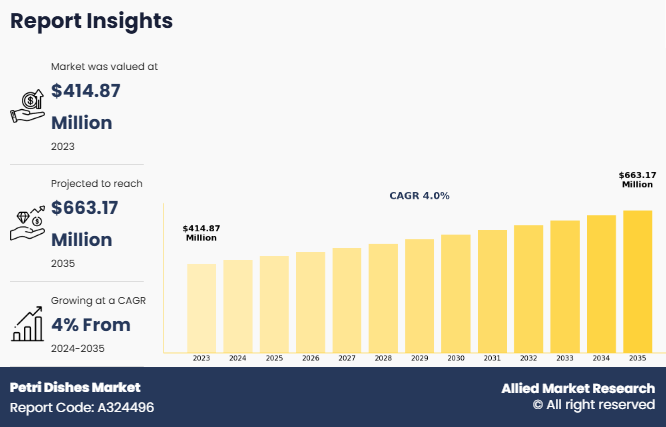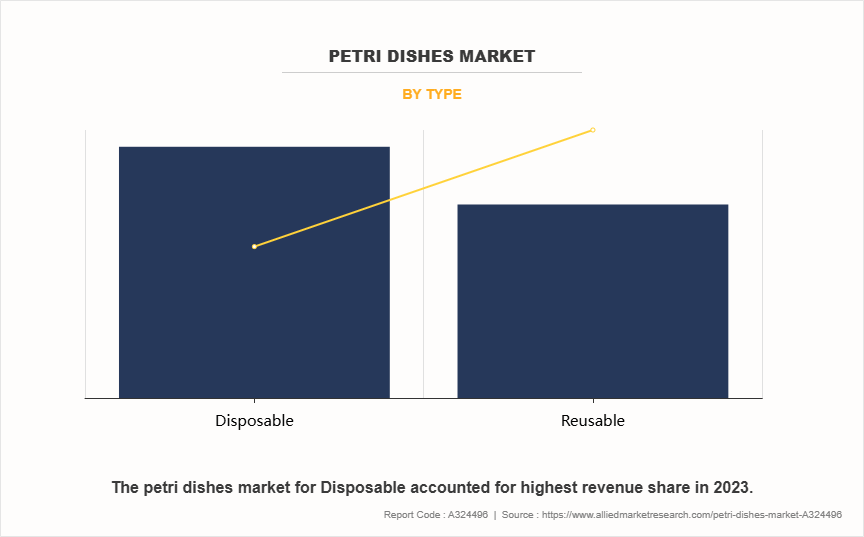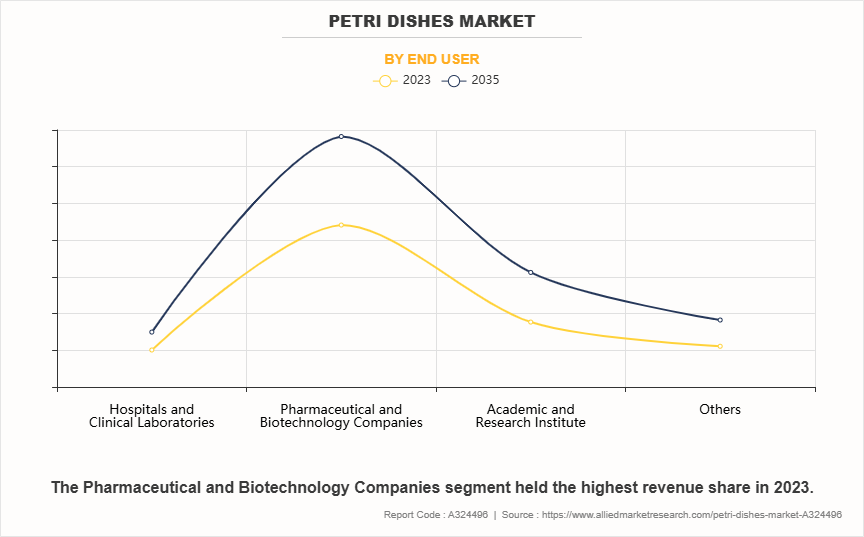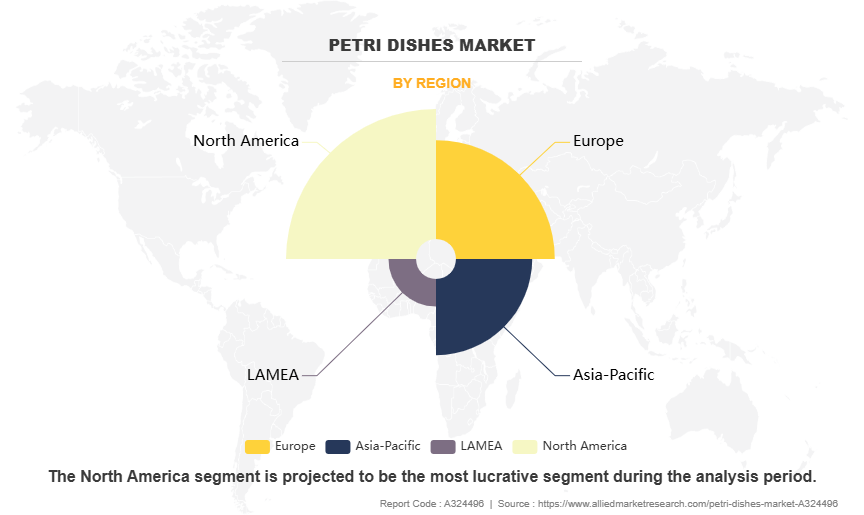Petri Dishes Market Research, 2035
The global petri dishes market size was valued at $414.9 million in 2023, and is projected to reach $663.2 million by 2035, growing at a CAGR of 4% from 2024 to 2035. The growth of the Petri dishes market is driven by the increasing volume of laboratory research activities and the rising prevalence of infectious diseases, which fuel the demand for petri dishes in microbiological studies and diagnostics. For instance, with the rise in global health concerns such as the spread of infectious diseases such as COVID-19, the demand for laboratory testing has surged.
Petri dishes are essential tools in microbial culture, infection testing, and pharmaceutical research, which directly contribute to market expansion. This growing focus on healthcare and research initiatives boosts the adoption of petri dishes across various sectors, including clinical diagnostics, pharmaceutical research, and environmental testing.

Key Takeaways
- By material, the plastic segment was the largest contributor to the market in 2023 and glass is expected to register the highest CAGR during the forecast period.
- By type, the disposable segment was largest contributor to the market in 2023 and is reusable is expected to register the highest CAGR during the forecast period.
- By end user, the pharmaceutical and biotechnology companies segment dominated the market in 2023, and academic and research institute segment is expected to grow at a highest CAGR during the forecast period.
- Region wise, North America generated the largest revenue in 2023. However, Asia-Pacific is anticipated to grow at the highest CAGR during the forecast period.
Petri dishes are shallow, flat, cylindrical containers typically made of glass or plastic, used for culturing microorganisms in laboratory settings. They are widely employed in microbiology for the growth of bacteria, fungi, and other cells, making them essential tools in research, diagnostics, and pharmaceutical development. Petri dishes are also used in environmental testing and agricultural studies. Their transparent nature allows for easy observation and examination of microbial growth, contributing to their widespread use in scientific research and clinical laboratories.
Market Dynamics
The global petri dishes market size is driven by several key factors, including the increasing demand for laboratory tools in clinical diagnostics, the growing focus on research and development in biotechnology and pharmaceuticals, and advancements in manufacturing technology. Rise in number of diagnostic tests, particularly in the wake of global health challenges such as the COVID-19 pandemic, has amplified the need for reliable laboratory tools such as petri dishes. Further, the increasing prevalence of chronic diseases and infectious diseases is also propelling demand for research, contributing to the growing usage of petri dishes in microbiology, molecular biology, and clinical diagnostics.
Another factor that drives petri dishes market growth is the increase in adoption of disposable petri dishes in laboratories. These dishes offer significant advantages over reusable alternatives, including convenience, hygiene, and cost-effectiveness. The use of disposable petri dishes has been accelerated in hospitals and research institutions due to their ability to prevent contamination and reduce the risk of cross-infection, which is particularly critical in clinical microbiology. Disposable petri dishes are also widely used in drug development, environmental testing, and food safety testing, where contamination control is a critical concern.
The development of new materials and manufacturing technologies has also played a significant role in propelling the petri dishes market growth. Modern petri dishes are made of high-quality plastics such as polystyrene, which are lightweight, durable, and cost-effective. The introduction of low-adhesion and bio-degradable petri dishes is expected to contribute to the overall growth of the market. For example, the recent innovation of biodegradable petri dishes made from plant-based materials offers a sustainable alternative to traditional plastic petri dishes.
However, there are several restraints that could hinder the market's growth. One of the primary challenges is the availability of substitutes, such as culture plates and microplates, which can offer similar functionality and are sometimes more cost-effective in high-throughput applications. In addition, while disposable petri dishes are gaining popularity, concerns related to plastic waste and environmental impact have led to growing resistance to their use. This is prompting industry players to invest in research to develop more sustainable alternatives, but the process is still in its early stages.
Moreover, the high cost of high-quality petri dishes, particularly those made with specialized materials or advanced features such as low-adhesion surfaces, may act as a barrier to adoption in cost-sensitive regions, especially in developing economies. This could potentially limit the growth of the petri dishes market, particularly in areas with low healthcare spending or limited laboratory infrastructure.
Despite these restraints, the market presents significant opportunities for growth during petri dishes market forecast. As research and development investments in the healthcare and biotechnology sectors continue to rise, demand for laboratory supplies, including petri dishes, is expected to increase. In addition, emerging markets, particularly in Asia-Pacific, are seeing a surge in laboratory setup and the expansion of diagnostic testing capacities. In countries such as India, China, and South Korea, the rise in health awareness and the growing number of biotechnology and pharmaceutical research initiatives are boosting demand for laboratory consumables, including petri dishes.
Another exciting opportunity lies in the increasing use of petri dishes in emerging applications such as personalized medicine and microbiome research. The growing focus on the human microbiome, particularly in understanding its impact on health and disease, is driving demand for laboratory tools that can support this research. Petri dishes are essential in the culturing of microorganisms, which is vital for microbiome studies, and companies are capitalizing on this trend by developing products specifically tailored for microbiome research. Furthermore, petri dishes are increasingly used in the study of cancer, as they are essential for cultivating cancer cells for drug testing and research. The adoption of petri dishes in these advanced applications represents a significant opportunity for market growth.
Segmental Overview
The petri dishes industry is segmented into material, type, end user, and region. On the basis of material, it is bifurcated into plastic and glass. On the basis of type, the market is segregated into reusable and disposable. On the basis of end user, the market is categorized into hospitals & clinical laboratories, pharmaceutical & biotechnology companies, academic & research institutes, and others.
Region wise, the market is analyzed across North America (U.S., Canada, and Mexico), Europe (Germany, France, UK, Italy, Spain, and rest of Europe), Asia-Pacific (Japan, China, India, Australia, South Korea, and rest of Asia-Pacific), and LAMEA (Brazil, South Africa, Saudi Arabia, and rest of LAMEA).
By Material
The plastic segment dominated the petri dishes industry in 2023 due to its cost-effectiveness, durability, and versatility. Plastic petri dishes, typically made from polystyrene, are lightweight, disposable, and offer a wide range of applications in microbiology, clinical diagnostics, and pharmaceutical research. On the other hand, the glass segment is expected to register the highest CAGR during the forecast period as it is favored for its reusability, chemical resistance, and suitability in high-precision laboratory environments. Glass petri dishes are also gaining popularity due to increasing demand for eco-friendly and sustainable laboratory tools, as they can be sterilized and reused, reducing waste.

By Type
The disposable petri dishes segment was the largest contributor to the market in 2023, primarily driven by their convenience, hygiene, and cost-effectiveness. Disposable petri dishes are preferred in clinical and laboratory settings to prevent contamination and ensure a sterile environment, particularly in high-volume applications. However, the reusable segment is expected to register the highest CAGR during the forecast period, as laboratories and research institutions are increasingly focusing on sustainability and cost-efficiency. Reusable petri dishes, which can be sterilized and used multiple times, align with these trends, particularly in high-precision or long-term research environments where durability and repeatability are essential.

By End User
The pharmaceutical and biotechnology companies segment dominated the petri dishes market share in 2023 due to significant demand for laboratory tools in drug discovery, development, and clinical testing. These companies require petri dishes for various applications such as microbial testing, cell culture, and genetic research. However, the academic and research institute segment is expected to grow at the highest CAGR during the forecast period due to increasing investments in scientific research and advancements in biotechnology. As research activities expand globally, especially in areas such as microbiome studies and personalized medicine, academic institutions will see a rising demand for petri dishes to support these growing research initiatives.

By Region
North America dominated the petri dishes market share in 2023 due to its well-established healthcare infrastructure, high research and development spending, and the presence of major pharmaceutical and biotechnology companies. The region’s advanced diagnostic capabilities, along with a strong focus on medical and scientific research, contributed significantly to the demand for petri dishes. The increasing adoption of automated laboratory systems and rising awareness of environmental sustainability also played a key role in driving market growth in North America.
However, Asia-Pacific is anticipated to grow at the highest CAGR during the forecast period due to the rapid expansion of the healthcare and biotechnology sectors in countries such as China, India, and Japan. The region’s growing investments in medical research, diagnostics, and pharmaceutical production are fueling the demand for laboratory tools, including petri dishes. In addition, the increasing prevalence of infectious diseases and the expanding middle class, which drives healthcare access and awareness, are contributing to this growth.
Furthermore, Asia-Pacific is home to many contract research organizations (CROs) and academic institutions focused on cutting-edge research, creating substantial demand for petri dishes in microbiology, molecular biology, and pharmaceutical studies. These factors, coupled with cost-effective manufacturing and a focus on research-driven development, position Asia-Pacific as a rapidly growing region in the petri dishes market.

Competition Analysis
Major key players that operate in the global petri dishes market are Corning Incorporated, Wuxi NEST Biotechnology Co., Ltd., Crystalgen, Inc., Sumitomo Bakelite Co., Ltd., SARSTEDT AG & Co. KG, Thermo Fisher Scientific Inc., Geriner Bio One, Celltraet Scientific Products, Becton, Dickinson and Company, and Merck KGaA.
Key Benefits For Stakeholders
- This report provides a quantitative analysis of the market segments, current trends, estimations, and dynamics of the petri dishes market analysis from 2023 to 2035 to identify the prevailing petri dishes market opportunity.
- The market research is offered along with information related to key drivers, restraints, and opportunities.
- Porter's five forces analysis highlights the potency of buyers and suppliers to enable stakeholders make profit-oriented business decisions and strengthen their supplier-buyer network.
- In-depth analysis of the petri dishes market segmentation assists to determine the prevailing market opportunities.
- Major countries in each region are mapped according to their revenue contribution to the global market.
- Market player positioning facilitates benchmarking and provides a clear understanding of the present position of the market players.
- The report includes the analysis of the regional as well as global petri dishes market trends, key players, market segments, application areas, and market growth strategies.
Petri Dishes Market Report Highlights
| Aspects | Details |
| Market Size By 2035 | USD 663.2 million |
| Growth Rate | CAGR of 4% |
| Forecast period | 2023 - 2035 |
| Report Pages | 290 |
| By Material |
|
| By Type |
|
| By End User |
|
| By Region |
|
| Key Market Players | Crystalgen, Inc., Thermo Fisher Scientific Inc., Celltraet Scientific Products, Geriner AG, Sumitomo Bakelite Co., Ltd., Merck KGaA, Corning Incorporated, SARSTEDT AG & Co. KG, Becton, Dickinson and Company, Wuxi NEST Biotechnology Co., Ltd. |
Analyst Review
The Petri dish market has expanded due to the increasing demand for microbiological research, particularly in the fields of pharmaceuticals, food safety, and clinical diagnostics. The rise in infectious diseases, the growing emphasis on microbial studies, and the increasing use of Petri dishes in diagnostics have significantly contributed to market growth. Advancements in Petri dish materials, such as biodegradable and high-quality polystyrene dishes, further drive the adoption of Petri dishes in research laboratories and clinical settings.
The government initiatives to improve healthcare research infrastructure and the growing emphasis on pathogen-related research are fueling market growth. In addition, the rising trend of personalized medicine and the expanding applications in genetic research are supporting market expansion. The shift toward sustainable solutions, such as eco-friendly and reusable Petri dishes, also presents growth opportunities in the market.
North America generated the largest revenue in 2023, owing to its advanced healthcare infrastructure, extensive research activities, and high demand for laboratory consumables. The region’s dominance is further supported by continuous technological innovations and product developments in laboratory tools and consumables. However, the Asia-Pacific region is expected to register the highest CAGR during the forecast period, driven by the increasing prevalence of infectious diseases, the growing adoption of advanced laboratory technologies, and substantial investments in healthcare and biotechnology research.
The top companies holding a significant market share in the Petri dishes market include Thermo Fisher Scientific, Corning Inc., Greiner Bio-One, and Merck KGaA. These companies dominate due to their extensive product portfolios, strong distribution networks, and continuous innovations in material technology and automation-compatible Petri dishes.
The petri dishes market was valued at $414.87 million in 2023 and is estimated to reach $663.18 million by 2035, exhibiting a CAGR of 4.0% from 2024 to 2035.
North America is the largest regional market for Petri dishes, driven by its well-established healthcare, biotechnology, and pharmaceutical industries. The region's high demand for microbiological research, clinical diagnostics, and drug development, along with strong government funding for life sciences research, contributes to its market dominance. Additionally, stringent biosafety regulations and advanced laboratory infrastructure further support market growth.
The leading application of the Petri dishes market is in microbiological research and diagnostics, primarily in clinical laboratories, hospitals, and pharmaceutical industries. Petri dishes are widely used for bacterial and fungal culture testing, aiding in disease diagnosis, drug development, and antibiotic susceptibility studies. Their critical role in food safety testing and environmental monitoring further strengthens their market demand.
The Petri dishes market is witnessing emerging trends such as the growing adoption of automated and high-throughput laboratory systems, increasing demand for biodegradable and sustainable materials to reduce plastic waste, and advancements in pre-sterilized and specialty-coated Petri dishes for enhanced microbial growth studies. Additionally, the expanding applications in food safety testing, environmental monitoring, and personalized medicine research are driving innovation in the market.
Loading Table Of Content...
Loading Research Methodology...



